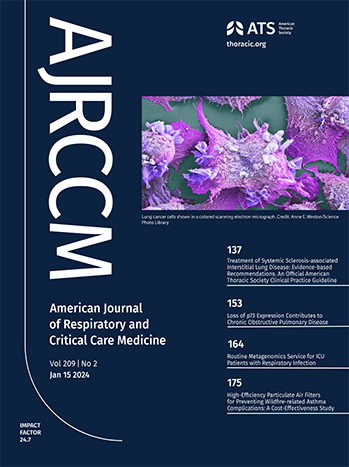Patient Factors and Clinical Efficacy of Early Identification and Treatment of COPD and Asthma.
IF 19.4
1区 医学
Q1 CRITICAL CARE MEDICINE
American journal of respiratory and critical care medicine
Pub Date : 2025-10-07
DOI:10.1164/rccm.202505-1260oc
引用次数: 0
Abstract
RATIONALE The Undiagnosed COPD and Asthma Population trial showed that early diagnosis and treatment of asthma and COPD by pulmonologists improved healthcare utilization, respiratory symptoms, and quality of life. OBJECTIVES To determine if the benefits of early diagnosis and treatment were greater in individuals with more advanced disease, or in individuals with asthma as opposed to COPD. We also assessed whether pulmonologist-directed care benefited asthma and COPD subgroups equally. METHODS Case finding was used to identify undiagnosed adults with chronic respiratory symptoms in the community. Five hundred and eight newly diagnosed participants with COPD or asthma were randomized to a pulmonologist-care intervention or usual care. Low and high disease-burden categories for St. Georges Respiratory Questionnaire (SGRQ) and COPD Assessment Test (CAT) were defined using a median-split of baseline scores, and MCID thresholds were used to define significant responses. Benefits of pulmonologist care were assessed by evaluating treatment effects within subgroups and by assessing treatment-by-subgroup interactions. MEASUREMENTS AND MAIN RESULTS Patients with higher disease burden at diagnosis were more likely to benefit from early diagnosis and treatment compared to those with lower disease-burden. 71% of those with high disease-burden improved their CAT by ≥ 2 points over 12 months compared to 47% with low disease burden; OR 2.78, 95% CI: 1.90 to 4.07, p<0.001. Similar results were seen for SGRQ and FEV1 improvements. In contrast, responses to early diagnosis and treatment were similar for those with asthma vs COPD. Individuals with asthma randomized to pulmonologist-directed care showed greater one-year improvements in CAT, SGRQ, SF36 and FEV1 compared to individuals randomized to primary care. However, individuals with COPD experienced similar improvements regardless of whether their treatment was managed by a pulmonologist or primary care provider. Treatment-by-disease interaction terms were not statistically significant. CONCLUSIONS Patients with greater disease burden who exhibited more advanced and symptomatic asthma and COPD at the time of diagnosis, benefited more from earlier diagnosis and treatment. Patients with asthma tended to derive greater benefit from pulmonologist-directed care than patients with COPD.慢性阻塞性肺病和哮喘患者因素及早期识别和治疗的临床疗效。
理由:未确诊的慢性阻塞性肺病和哮喘人群试验表明,肺科医生对哮喘和慢性阻塞性肺病的早期诊断和治疗可改善医疗保健利用率、呼吸道症状和生活质量。目的:确定早期诊断和治疗的益处是否在病情较晚期的个体中更大,或者在哮喘患者中比在COPD患者中更大。我们还评估了肺科医生指导的护理对哮喘和COPD亚组的益处是否相同。方法采用病例发现法,对社区中未确诊的慢性呼吸道症状成人进行鉴定。580名新诊断为慢性阻塞性肺病或哮喘的参与者被随机分配到肺科护理干预组或常规护理组。圣乔治呼吸问卷(SGRQ)和COPD评估测试(CAT)的低和高疾病负担类别使用基线得分的中位数分割来定义,并使用MCID阈值来定义显著反应。通过评估亚组内的治疗效果和评估逐个亚组治疗的相互作用来评估肺科医生护理的益处。测量方法和主要结果诊断时疾病负担较高的患者比疾病负担较低的患者更有可能从早期诊断和治疗中获益。高疾病负担患者的CAT在12个月内改善≥2点的占71%,而低疾病负担患者的这一比例为47%;OR 2.78, 95% CI: 1.90 ~ 4.07, p<0.001。SGRQ和FEV1的改善也有类似的结果。相比之下,哮喘和COPD患者对早期诊断和治疗的反应相似。与随机分配到初级保健的个体相比,随机分配到肺科医生指导护理的哮喘个体在CAT、SGRQ、SF36和FEV1方面显示出更大的一年改善。然而,慢性阻塞性肺病患者无论他们的治疗是由肺科医生还是初级保健提供者管理,都经历了类似的改善。按疾病治疗的相互作用项无统计学意义。结论疾病负担大的患者在诊断时表现出更晚期、更有症状的哮喘和COPD,早期诊断和治疗获益更多。哮喘患者往往比COPD患者从肺病专家指导的护理中获得更大的益处。
本文章由计算机程序翻译,如有差异,请以英文原文为准。
求助全文
约1分钟内获得全文
求助全文
来源期刊
CiteScore
27.30
自引率
4.50%
发文量
1313
审稿时长
3-6 weeks
期刊介绍:
The American Journal of Respiratory and Critical Care Medicine focuses on human biology and disease, as well as animal studies that contribute to the understanding of pathophysiology and treatment of diseases that affect the respiratory system and critically ill patients. Papers that are solely or predominantly based in cell and molecular biology are published in the companion journal, the American Journal of Respiratory Cell and Molecular Biology. The Journal also seeks to publish clinical trials and outstanding review articles on areas of interest in several forms. The State-of-the-Art review is a treatise usually covering a broad field that brings bench research to the bedside. Shorter reviews are published as Critical Care Perspectives or Pulmonary Perspectives. These are generally focused on a more limited area and advance a concerted opinion about care for a specific process. Concise Clinical Reviews provide an evidence-based synthesis of the literature pertaining to topics of fundamental importance to the practice of pulmonary, critical care, and sleep medicine. Images providing advances or unusual contributions to the field are published as Images in Pulmonary, Critical Care, Sleep Medicine and the Sciences.
A recent trend and future direction of the Journal has been to include debates of a topical nature on issues of importance in pulmonary and critical care medicine and to the membership of the American Thoracic Society. Other recent changes have included encompassing works from the field of critical care medicine and the extension of the editorial governing of journal policy to colleagues outside of the United States of America. The focus and direction of the Journal is to establish an international forum for state-of-the-art respiratory and critical care medicine.

 求助内容:
求助内容: 应助结果提醒方式:
应助结果提醒方式:


